
- ChatGPT - Home
- ChatGPT - Fundamentals
- ChatGPT - Getting Started
- ChatGPT - How It Works
- ChatGPT - Prompts
- ChatGPT - Competitors
- ChatGPT - For Content Creation
- ChatGPT - For Marketing
- ChatGPT - For Job Seekers
- ChatGPT - For Code Writing
- ChatGPT - For SEO
- ChatGPT - For Business
- ChatGPT - Machine Learning
- ChatGPT - Generative AI
- ChatGPT - Build a Chatbot
- ChatGPT - Plugin
- ChatGPT - GPT-4o (Omni)
- ChatGPT in Excel
- ChatGPT for Test Automation
- ChatGPT on Android
- Make Money with ChatGPT
- ChatGPT for UI/UX Designers
- ChatGPT for Web Developers
- ChatGPT for Data Scientists
- ChatGPT for Bloggers
- ChatGPT for Personal Finance Management
- Automate Customer Support with ChatGPT
- Create Content Calendars with ChatGPT
- Plan Events and Trips with ChatGPT
- Draft Legal Documents with ChatGPT
- Improve Your Coding Skills with ChatGPT
- New Language with ChatGPT
- Optimize ChatGPT Responses for Better Accuracy
- ChatGPT Useful Resources
- ChatGPT - Quick Guide
- ChatGPT - Useful Resources
- ChatGPT - Discussion
Learn a New Language with ChatGPT
Learning a new language excites and challenges you. With AI-powered tools like ChatGPT, you can practice and improve your language skills anytime, anywhere.
This step-by-step tutorial will show you how to effectively use ChatGPT to learn a new language, whether you are a beginner or looking to enhance your fluency.
Step 1: Choose Your Target Language
Before you get started, choose the language you wish to learn. Some commonly chosen options include Spanish, French, German, Mandarin, and Japanese. Your interests, professional aspirations, or travel intentions may influence your decision.
Step 2: Set Clear Learning Goals
Defining your goals will keep you motivated and help you measure your progress. Consider the following questions −
- Do you want to become conversational in three months?
- Are you learning for business, travel, or personal interest?
- Do you want to focus on speaking, writing, listening, or all of them?
Setting specific goals will make your learning process more structured and effective.
Step 3: Start with Basic Vocabulary and Phrases
Before getting into grammar, it's crucial to establish a solid base with fundamental vocabulary and key phrases. Here’s how ChatGPT can assist −
- Ask, "What are the 50 most common words in [language]?"
- Request translations for everyday expressions such as "Hello," "How are you?", and "Thank you."
- Use prompts like "Provide me with 10 essential phrases for travelers in [language]."
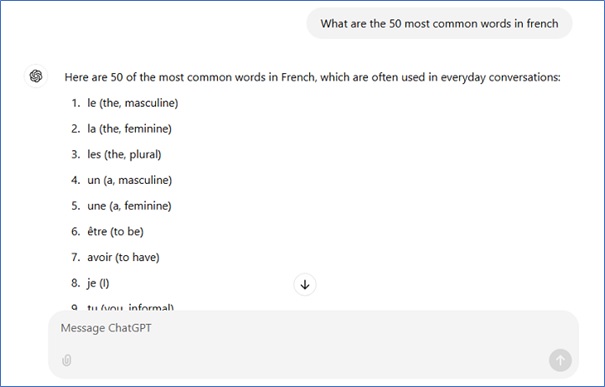
Step 4: Practice Pronunciation
Proper pronunciation is essential for clear communication. Utilize ChatGPT alongside text-to-speech tools −
- Request ChatGPT to provide phonetic spellings of words.
- Employ voice assistants such as Google Translate or Forvo to listen to native pronunciations.
Practice mimicking the sounds and ask ChatGPT, "What is the correct pronunciation of [word] in [language]?"
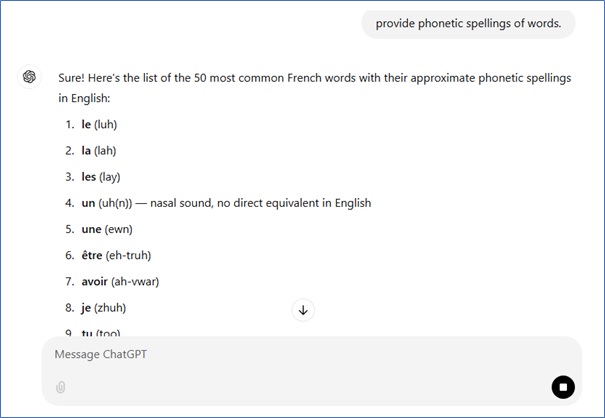
Step 5: Learn Grammar Rules Step by Step
Grammar can seem overwhelming, so break it down into smaller, more manageable sections −
- Start with basic sentence structures (like subject-verb-object).
- Get to know common verb conjugations (for present, past, and future tenses).
- Ask ChatGPT to "Explain verb conjugation in [language] with examples."
- Request simple exercises, such as "Create five sentences using the past tense in [language]."
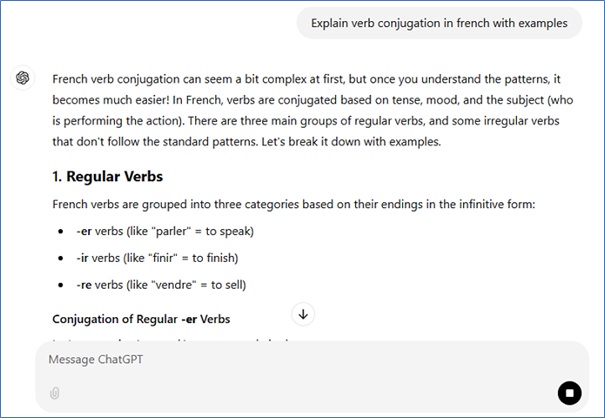
Step 6: Engage in Daily Conversations
Engaging in authentic conversations serves as one of the most effective ways to learn. You can use ChatGPT as your language partner in several helpful ways −
- Start with simple dialogues − "Can we have a brief conversation in [language]?"
- Try role-play scenarios − "Let's pretend you're a waiter at a French restaurant, and I'll place my order in French."
- Request conversation starters − "Can you provide me with five questions to initiate a discussion in [language]?"
- If you make mistakes, ask, "Could you help me correct my sentence: [your sentence]?"
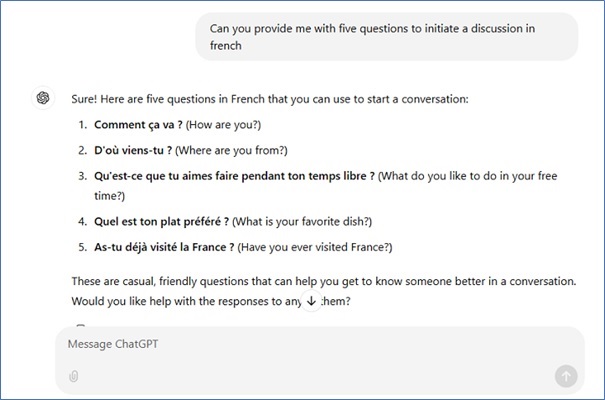
Step 7: Read and Translate Texts
Reading enhances vocabulary and comprehension. You can −
- Ask for short texts: "Provide me with a short story in [language] and include the English translation."
- Translate texts: "Translate this paragraph into [language]."
- Read simple news articles and ask ChatGPT to summarize them in easy-to-understand language.
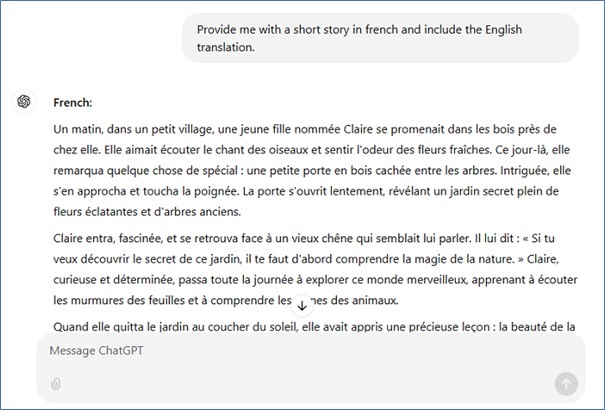
Step 8: Improve Your Writing Skills
Writing helps reinforce what you learn. You can −
- Write a daily journal and ask ChatGPT to correct it.
- Request writing prompts: "Give me a topic to write about in [language]."
- Ask ChatGPT to provide feedback: "Can you check my writing for grammar mistakes?"
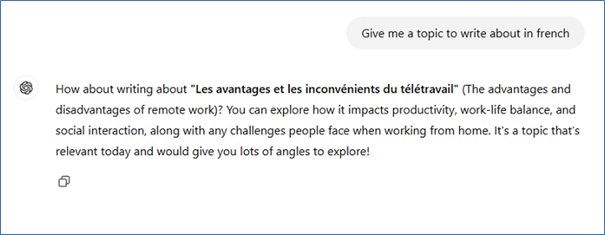
Step 9: Listen and Comprehend
Listening is a crucial skill for language learning. Here’s how you can use ChatGPT to enhance your listening skills −
- Ask ChatGPT for recommended podcasts or audiobooks in your target language.
- Request ChatGPT to create comprehension exercises: "Give me a short dialogue in [language] and ask questions about it."
- Listen to music in your target language and ask ChatGPT to explain the lyrics.
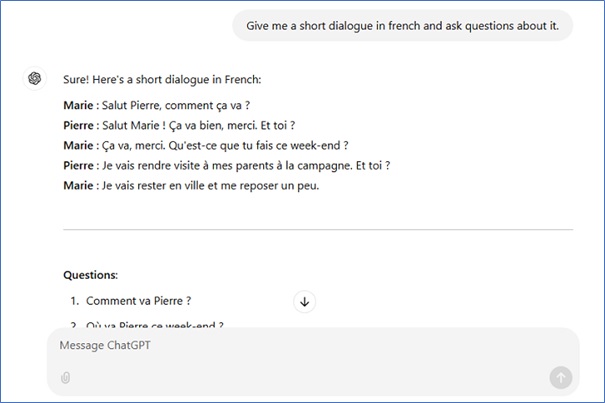
Step 10: Play Language Games
Make learning fun with interactive exercises −
- You can request a vocabulary quiz: "Test me on 20 basic words in [language]."
- You can ask for fill-in-the-blank exercises: "Create a fill-in-the-blank sentence using [word] in [language]."
- You can try word association games: "Give me a word in [language], and I'll respond with a related word."
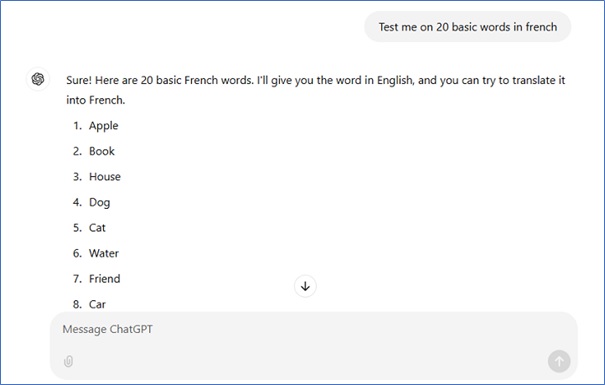
Step 11: Track Your Progress
Keep a record of your learning to stay motivated −
- Regularly maintain a vocabulary list and review it weekly.
- Ask ChatGPT to quiz you on what you’ve learned.
- Record your spoken sentences and compare them over time to track your improvements.
Step 12: Immerse Yourself in the Language
Full immersion speeds up learning. You can −
- Set your phone or computer settings to the target language.
- Watch movies or YouTube videos in the language.
- Join online language communities and practice with native speakers.
Conclusion
ChatGPT is a helpful resource that can enhance your language learning experience. By establishing clear objectives and maintaining consistency, you can learn a new language effectively and at your own speed.